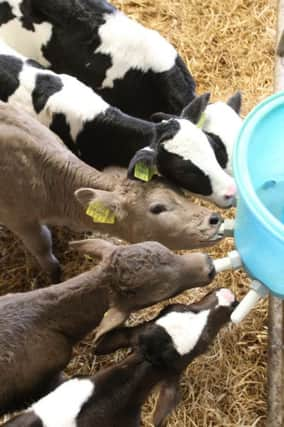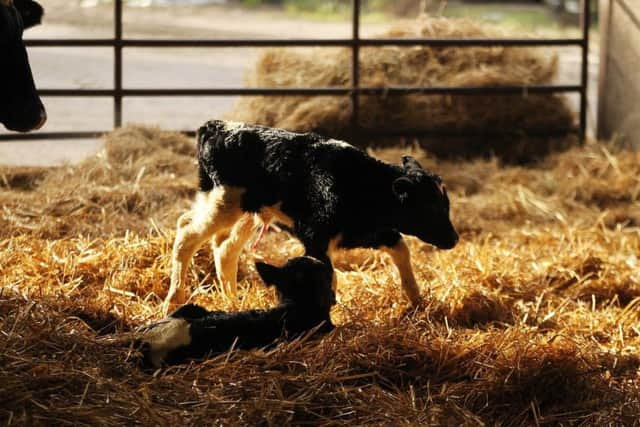Controlling calf disease in early life - an investment in future productivity


The importance of
colostrum
Immunity does not transfer from the dam to the calf via the placenta. Therefore, when calves are born they have no immune protection from their dam and are vulnerable to infection immediately. This is why the cleanliness of the ground and the surrounding calving environment influences the number and level of disease-causing agents to which the calf is exposed.


In a clean and sufficiently ventilated environment the calf will be exposed to fewer of these agents and will, in turn, be less likely to become ill.
Advertisement
Hide AdAdvertisement
Hide AdColostrum is critical in order to provide the new-born calf with a supply of antibodies. This passive immunity provides protection against disease agents that cause diarrhoea and pneumonia during the first few weeks of life. It is imperative that the correct amount of high quality colostrum is given early to allow antibody absorption to occur. It is recommended that three to four litres of colostrum is given within two hours of birth. A further two to three-litre feed can be given four-six hours later.
Nipple or teat feeding, as opposed to stomach tubing, allows a greater proportion of immunoglobulins to be absorbed. However, if calves are weak or will not suck an adequate volume within the time frame, the first feed can be administered via a stomach tube. Colostrum collection and administration must be done in a hygienic manner. Otherwise disease agents such as rotavirus and Cryptosporidium parvum can be ingested with dirty colostrum, causing scour.
Managing scour


Assuming a hygienic calf environment and appropriately-timed colostrum administration, the next most important step in reducing the risk of scour on farm involves ensuring that the quality of the colostrum administered is adequate.
The new-born calf should be fed between 150 to 200 grams of immunoglobulins within the first 24 hours. However, the immunoglobulin level and therefore the quality of colostrum can vary between cows from less than 20 to over 100 mg/ml. Clearly three litres of colostrum from a cow with a quality of 100mg/ml will contain significantly more immunoglobulins compared to a cow with a quality of 20 mg/ml. The only way to get more immunoglobulins into a calf being fed poor quality colostrum is to increase the volume. Colostrum quality can be simply measured on farm using a colostrometer or a refractometer. Only good quality colostrum should be fed to calves.
Advertisement
Hide AdAdvertisement
Hide AdThe immunoglobulin level can be improved and homogenised between cows by vaccinating the cows against some of the most common scour-causing agents, namely rotavirus, coronavirus and E. coli K99. A single shot vaccine, Rotavec® Corona, can be administered to cows three to 12 weeks prior to calving so this can be achieved.
Tackling pneumonia
Research in Northern Ireland has shown that in the first two months of life, calves that are successfully treated for a single case of Bovine Respiratory Disease (BRD) produce 4% less milk in their first lactation and 8% less in their second. Therefore reducing the incidence of calf pneumonia makes economic sense.
The immunity or antibodies a calf receives from colostrum will wane at different rates for different diseases. One of the most common bacterial causes of respiratory disease-related deaths in new-born calves, diagnosed by AFBI NI is Mannheimia (formerly Pasteurella) haemolytica. Antibodies that help to defend against this bacterium fall below protective levels by approximately three weeks old.
For this reason it is important to prompt the calf’s own immune system to start developing protection against pneumonia. Calves from approximately two weeks old onwards should be vaccinated against respiratory disease. Bovipast® RSP for example, can be administered from two weeks of age with a second dose given four weeks later.
Advertisement
Hide AdAdvertisement
Hide AdThis vaccine provides the broadest protection against two common viruses, BRSV and PI-3, and Mannheimia (Pasteurella) haemolytica. It is important to note that Bovipast® RSP provides cross protection against both A1 and A6 strains of Mannheimia (Pasteurella) haemolytica which account for over 90% of cases caused by the bacterium.
Another advantage to this regimen is that Bovilis® IBR Marker Live can be given at the same time as Bovipast® RSP. This is useful if Infectious Bovine Rhinotracheitis virus (IBR) control is required on farm to improve the overall herd immunity by reducing the burden of infection over time.
Increased growth rates during the first few months of a calf’s life have been shown to be positively associated with future milk production and survivability to second lactation. Disease outbreaks reduce feed intake and therefore have a negative impact on calf performance.
A preventative plan should be put in place in order to reduce the likelihood of anything that will hinder growth, for example, diarrhoea or pneumonia. A proactive approach to calf health should in turn yield positive results during the lifetime of each animal within the herd.